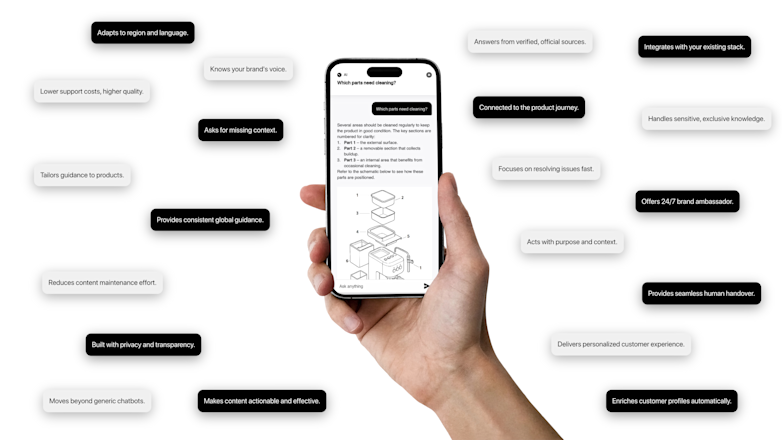
Customers are constantly communicating with businesses. From visiting the landing page, browsing products, placing an order, and leaving a review, every touchpoint with a prospect or a customer provides insights.
The ability to capture these insights in real-time makes a business responsive and profitable. Today’s customers expect solutions based on knowledge, instant results, and control to create a special experience. In this light, is CRM the best option? Perhaps not.
Marketing experts have stated that CRM is dead. CRM tools deliver insights that are not enough to meet a 21 century customer expectations. When you look at how businesses are evolving, it is clear that are moving away from traditional CRM tools.
Although cloud-based CRM models were an evolution, they are miserably failing now. Instead, a new category, called “the customer engagement platform,” has taken its place. This helps businesses replace their CRM software and guarantee a positive customer service experience across multiple channels.
The evolution of customer service
Before we get into how CRM has become outdated, let’s look at what customer service entails.
In layman’s terms, customer service is the support you offer your customers — both before and after they buy and use your products or services — that helps them have an easy, enjoyable experience with your brand. Providing quality support to customers increases their satisfaction and loyalty towards your brand. The same way, several studies show how poor customer service can tarnish the brand’s reputation.
The earliest customer service instances can be dated back to the 1960s, with the creation of call centers. Call centers allowed companies to provide support to customers in a centralized way. In these call centers, employees answered to phone calls from customers asking any kind of support and possibly redirect them to companies.
In 1967, AT&T announced the all-important American number, 1-800. This allowed customers to directly call the company they wanted to connect, without dealing with an operator from the call center. Cutting out this redundant step triggered improvements in the customer service.
The Interactive Voice Response or IVR invention was a breakthrough in customer service and started being commonly used arounf 1990s. This system allowed customers to call in and, by answering some yes or no questions, they were redirected to the right person. This way, rather than bouncing the customers from one number to the other, the IVR connected them with the right person who could solve their problems.
The advent of the Internet in the 1990s, created a new of opportunities to improve the customer experience. Customers no longer had to rely on physical visits or long calls to find out more about a business or to ask for support. Instant messaging allowed businesses to communicate with customers via e-mails and 1-on-1 chat, thus removing the middleman of IVR and traditional operators. Moreover, companies began using specialised customer support software which gradually replaced help desk solutions.
The ever-increasing popularity of social media since 2008 opened up yet another channel for customer service. This allowed companies to reach a greater customer base while customers could seek solutions to their problems quickly at anytime.
However, for years, companies associated customer service with having company personnel on the line 24/7 to answer questions and provide assistance. Companies would spend thousands of dollars on recruiting customer service staff who would sit behind a computer and go through a list of standard responses when customers had queries.
The purpose of providing excellent customer service was lost as the staff wanted to move on to the next customer in line as quickly as possible. Their job was done as long as they managed to sell a product or a service. With CRM, things started looking up once again, but not for long.
The downhill of the CRM
CRM stands for Customer Relationship Management. It refers to businesses’ tools, techniques, and strategies to develop, retain, and acquire new customers. CRM dashboards provide insights on customer behavior, such as overall purchase history, preferences, shopping cart abandonment rate, etc.
Today, CRM is incapable of delivering insights that benefit companies. Although the information on customer behavior stands necessary, through the CRM companies can only manage existing interactions. Meanwhile, customer service has shifted to engaging with customers in relevant ways throughout the customer interaction journey, which requires a customer engagement platform.
Businesses that implement CRM realise that these solutions are irrelevant. A recent Loudhouse survey of 800 senior sales executives proved significant tension in the present business climate between the desire for growth and the need to facilitate ongoing efficiencies. While most of the respondents were still using CRM technology, they believed that their systems needed overhauling.
Since customers are becoming more sophisticated and informed, CRM systems need to adapt. CRM only focuses on managing relationships and looking for ways to maximise revenue, but it’s time to maximise customer excellence from the start of the customer's journey.
What is coming next?
The main challenge facing businesses today is how they can deliver consistent customer excellence across all interactions and channels. Customer satisfaction and retention is as essential as the initial process of selling a product or a service. Also, since customer acquisition is more costly than customer retention, you better focus on the post-sales side. Businesses need to find ways to support customers in a holistic way that will make them want to return.
Providing an excellent customer journey can be an incredibly challenging task with so many competitors in the market. But, if companies figure out the right way to retain customers, they have a good chance of staying in business for decades. Complete traceability of customer interactions is imperative, and for this, businesses need a platform that can manage, unify, and secure underlying data. This should be supplemented with appropriate activity, personalized content and recommendations, and guiding customers.
Layerise goes one step ahead in combining unique customer experience abilities with CRM and marketing. This can help businesses foster ongoing customer relationships while building continuous revenue streams and attracting new customers.
Layerise helps companies in customer registration and collecting first-party data and creates educational and engaging product experiences, provides warranty management and conversational support, and sends personalized SMS marketing to customers. It is a one-stop-shop for every business’s customer excellence needs.
10 Ways To Deliver Customer Excellence
1. Know your products and services
The first step to providing customer excellence is knowing your products and services inside-out. Ideally, if you are going to spend resources troubleshooting for customers, you need to be a product expert.
You should believe in the products you offer, be able to discuss their use cases and features in a constructive way, and prove to your customers why they need your products. The job of customer excellence is to help customers get the most out of their purchase, and this is not possible if you don’t know have a deep understanding of your product.
2. Being friendly and maintaining a positive attitude
A friendly and positive attitude goes a long way in providing customer excellence. Companies should be proactive and anticipate their customer’s needs. Since most customer interactions are online now, your attitude should be reflected in your tone and language. Always remember that you need your customers more than they need you. Be nice.
3. Creative problem-solving
Use creative problem-solving to positively surprise your customers! Their response will surprise you too. When customers feel you are taking care of them, they won't find a reason to leave.
Zappos’ customer service story should be a role model of customer excellence. They sent a best man free shoes before the night of the wedding because his order was sent to the wrong location due to an error made by the delivery company. Zappos solved not only their customer’s problems but also set a benchmark of excellent customer service. They secured a customer for life.
Thus, don’t hesitate to go out of your way and wow your customers.
4. Listening actively
The simplest way to provide customer excellence is by listening actively. Most of the time, customers just need to be heard. Before pushing your own agenda, always listen to what your customers have to say. Make your customers feel that they are listened to and respected by your company. Customer service cannot be a one-size-fits-all solution, keep in mind every customer’s unique personality and temperament when listening to them.

5. Responding quickly
Almost 66 percent of customers believe that valuing their time is the most significant thing in any online customer service experience. This involves the promptness of replies. Resolving customer problems as quickly as possible is the cornerstone of providing quality customer excellence.
Always make it a point to return phone calls and emails within the first 24 hours. If a customer service request takes time, be honest with the customer and let them know how long it will take you to assist them.
6. Saying thank you
A simple “thank you” goes a long way when providing customer excellence. Customers always remember sincere gratitude, and it reassures them that choosing your company was the right choice.
Here you can find some ways in which you can thank customers for supporting your business:
Sending a handwritten thank-you note.
Adding something extra to the customer’s package.
Providing free samples.
Starting a loyalty or referral program.
Offering a special discount or coupon code.
7. Personalizing your service
A study on customer support reported that more than 40 percent of customers value human interaction, and this implies that they want to feel like more than a customer query or a ticket number. Everyone gets frustrated when they are not treated like a person, receive dead-end responses, or get batted like a tennis ball by different agents.
Customers want human interaction. The standalone way to provide customer excellence is by personalizing your services. Send your customers gifts on their birthdays, show them content and recommendations for products they are interested in, send them customized messages, etc.
8. Helping customers help themselves
Some customers would like to resolve their issues independently without having to go through the purpose of talking to company agents. More than 81 percent of customers attempt to solve their problems by themselves first before approaching customer support. 71 percent of customers want the ability to solve their own customer query tickets.
Self-service is the future of customer support. It is a scalable effort, and businesses should do everything to provide customers with self-service resources. Layerise has some incredible self-service features that businesses should get on board with to help their customers help themselves.
9. Getting to know your customers
Providing customer excellence means getting to know your customers, including who they are and what they want. Once you have a better understanding of your customers, you will be able to personalize customer service support and give them exactly what they are looking for. This will also give your business an edge over competitors.
To know your customers better, ask questions, conduct surveys, request feedback, and use social media channels effectively to look into their buying habits.
10. Keeping your word
Last but not least, if you have promised something to your customers, you need to keep your word. Keeping your word is about trust and respect, and no business should let its customers down.
If you have promised your customers that you will improve your product, stick to your word. If you have promised them that you will get back to them within 24 hours, make sure you don’t take a minute longer than that. With that being said, don’t make promises you can’t keep.
Now that you know what you need to provide the best customer experience, you will be happy to know that Layerise can help you in fulfilling all this 10 key dimensions of customer excellence. If you want to learn more about our solution, book a demo with us!
Learn how to collect valuable insights on your customers to sell even more.

How to Turn a New Obligation into a Growth with Layerise

A trusted, brand-safe AI assistant that knows your products, your customers and your content.


